How to bring home water from the well - the best solutions
Make a stay in a country house more comfortable by spending your own water supply. The presence of a nearby well or well is an excellent basis for arranging a water supply system. When carrying out such works, one may encounter difficulties, especially if such changes were not foreseen in the construction of the house.
However, using the necessary tools and examining the installation sequence of the equipment, you can lay a water pipe without the help of specialists. Thus, the cost of supplying water from the well to the house will be significantly reduced.
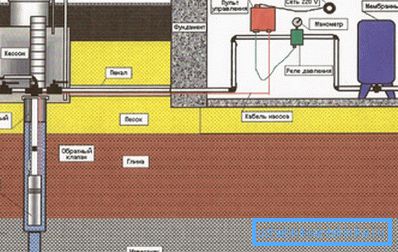
The main elements of the system
The scheme of water supply includes the following components.
- Pumping station. It is a set of pumping equipment, whose work allows you to create pressure in accordance with the required water flow. The station should be located as close as possible to consumers (basement, ground floor), the main thing is that the room is heated and would save water from freezing.
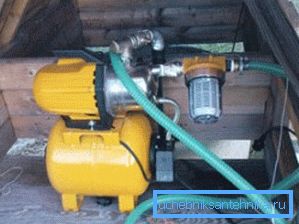
- Drain cock. The water supply to the house from the well is carried out through a pipe, which ends with a fitting having an adapter of diameters of 32 mm. A tee and a drain valve are connected to the fitting, which allows you to turn off the water during an emergency.
Tip! If the depth of the source does not exceed 8 m and it is located nearby from the house, then instead of a drain valve, a check valve is needed, in front of which there is a bypass installation with a crane. When the valve is opened, the vacuum goes off, thus causing the water to drain.
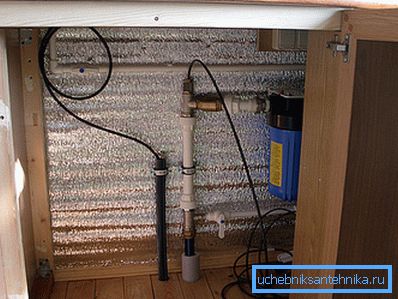
- Accumulator. The water supply to the house from the well also includes a hydraulic accumulator designed to maintain the necessary pressure and regulate the operation of the pump. It is a divided into two parts capacity, in one part of which there is air, and in the other - water.
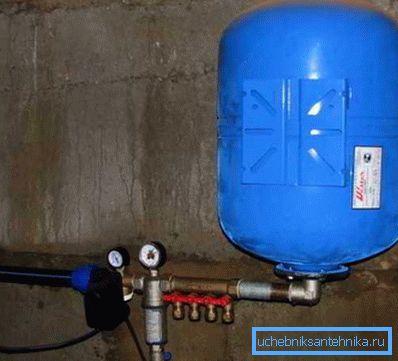
For your information: The hydroaccumulator works as follows. When filled with water in the water supply, the pressure reaches 3 bar. When the tap is opened, a pressure drop occurs as water flows.
After that, the relay is activated, which turns on the pump. As a result, the pressure rises again to the required values.
Capacity can be 25-500 l, the choice depends on the number of people living in the house. When arranging a water supply system with your own hands, installing an accumulator is optional; you can put a large tank in the attic, the mass and volume of water in which will provide the necessary pressure in the system.
- Pressure switch it is mounted immediately after the hydroaccumulator. This device is necessary to control and regulate the constant pressure in the system. The pump supplies water to the battery capacity, and the relay, if required, reduces or increases the pressure. When the maximum value is reached, a relay is triggered, which switches off the pump. Reducing the pressure causes the pump to turn on again.
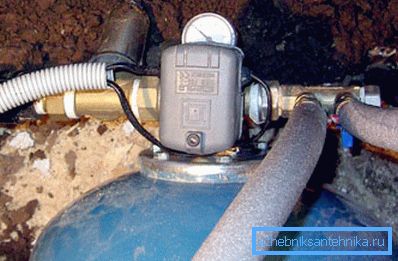
- Pipes for water supply. It is recommended to use pipes made of polypropylene, since they are distinguished by sufficient strength, reliability and reasonable price. In addition, you will need to lay a water heating wire that will protect the water from freezing.
Technology of bringing water to the house
Putting water into a house from a well requires, first of all, a special approach to the choice of pipes. Now manufacturers offer a large selection of products from various materials. It can be cast-iron, metal-plastic, steel pipes (see also the article “Construction of a well directly on its own summer cottage”).
But it is recommended to give preference to polymeric materials, because they are light, easy to install and have a long service life. When organizing the external water supply, pipes of the same grade should be used, this will facilitate the assembly and ensure sufficient tightness of the connections.
The following instructions will tell you about the sequence of laying and leading pipes to the house:
- At the preparatory stage, they are digging a trench. The depth of the resulting ditch should be sufficient so that in winter the pipe does not freeze. As for the width, it can be 0.3-0.5 m, the main thing in this case is the convenience of work. If you do not dig a trench to the required depth, then a heating cable is laid to the pipes.

- The pipes must be insulated with a foam rubber nozzle. After they are placed in a trench, a sheet of polystyrene 30 mm thick is laid on top, and covered with earth, constantly tamping. When installing pipes, it is necessary to ensure that there is a slope towards the house of approximately one degree. Compliance with this rule will avoid air traffic jams.
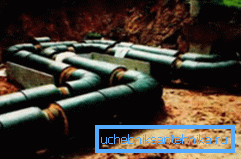
- To ensure the passage of the pipe into the well, a hole is made in the wall. After that, its end with the attached cleaning filter is lowered into the water at a distance of no more than half a meter from its surface. This depth will be sufficient to maintain a constant supply of water.
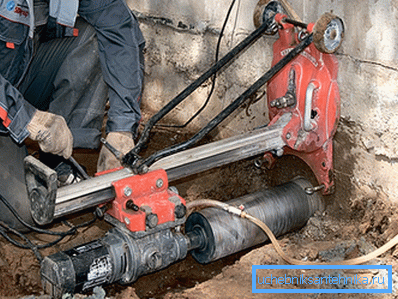
- Further, as the water supply to the house shows from the well, a hole is made or drilled in the wall of the house to pass the other end of the pipe. After connecting it, the hole is sealed with cement mixture and foamed.
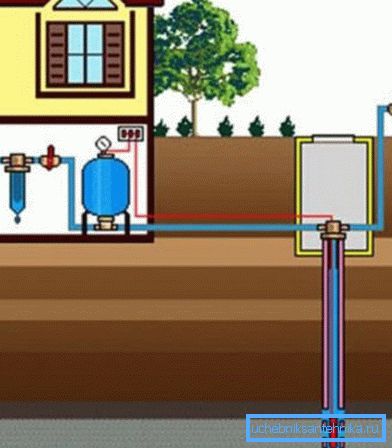
Distribution of water pipes in the house
Before work is necessary to choose the most suitable material.
It can be:
- Copper pipes are the most reliable elements, but at the same time the most expensive.

- Iron products are fairly durable, but susceptible to corrosion.
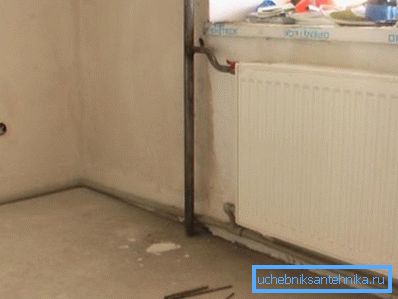
- Metal-plastic is resistant to corrosion, but is sensitive to the freezing of water and for bending more than 90 degrees requires the use of fittings.
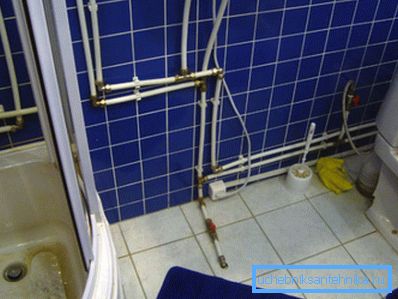
- Polypropylene is currently the most popular option.

Tip: Pipe wiring is carried out starting from the water intake point. A tap is installed between the consumer and the pipe, which allows the water to be shut off in the event of an accident. After that from the pipe there is a collector.
When carrying out work it is necessary to follow such rules.
- The main rule - the smaller the angles and transitions, the higher the pressure in the system.
- It is not recommended to lay pipes through walls, partitions and other structures. If you still can not avoid this, the pipe should be enclosed in a special plastic cup.
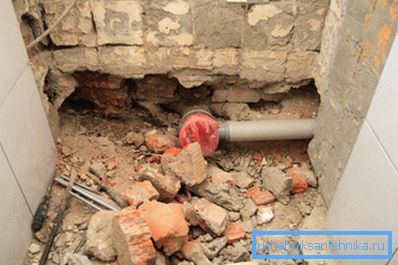
- To ensure free access to the pipes during their repair, they should be fixed at a distance of at least 20 mm from the wall.
- When bypassing the outer corner of the room, the pipe is placed at a distance of one and a half centimeters from the wall. When bypassing the inner corner - 0.4 cm.
- The pipes are fixed to the walls with the help of clips (see photo), which are placed at a distance of one and a half to two meters from each other. These elements must be present in the corner joints.

- For reliable fastening of pipes at an angle, special PND fittings and tees should be used, the diameter of which will be equal to the diameter of the pipes.
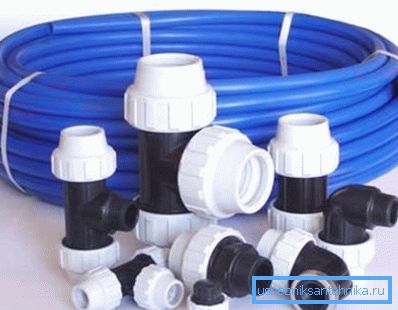
- When installing the drain valve is recommended to make a bias towards the mixer.
- When connecting pipes to the collector, it is important to install shut-off valves, which in case of repair will allow disconnecting the consumer from the water supply.
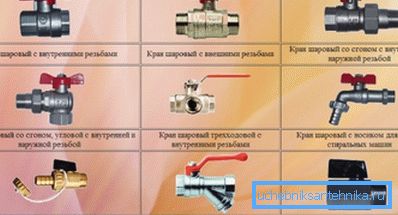
Conclusion
The advantage of an autonomous water supply system is independence from central communications. The water supply system carried out from the well is distinguished by low cost, practicality and efficiency (find out here how to dig the well yourself).
At the same time it is possible to arrange it independently without the help of specialists, for this it is useful to watch the video in this article.